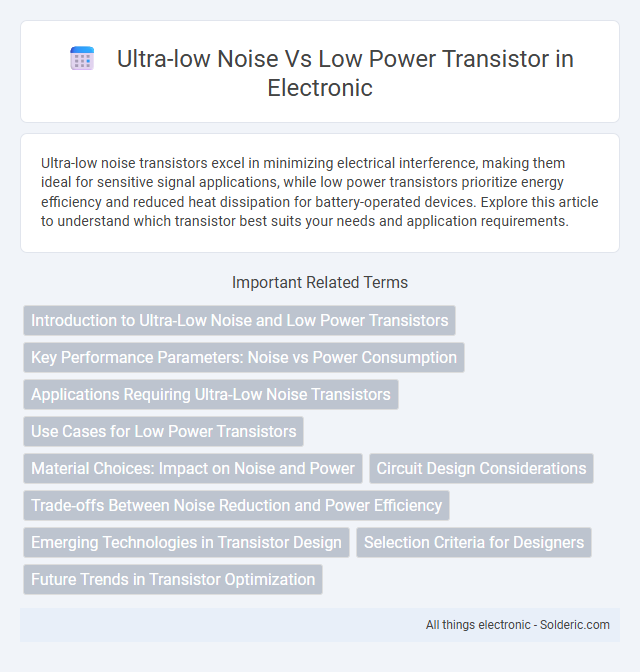Ultra-low noise transistors excel in minimizing electrical interference, making them ideal for sensitive signal applications, while low power transistors prioritize energy efficiency and reduced heat dissipation for battery-operated devices. Explore this article to understand which transistor best suits your needs and application requirements.
Comparison Table
| Feature | Ultra-Low Noise Transistor | Low Power Transistor |
|---|---|---|
| Primary Focus | Minimizing electrical noise for high-fidelity signal amplification | Reducing power consumption to enhance energy efficiency |
| Typical Applications | RF amplifiers, sensitive audio circuits, precision instrumentation | Battery-powered devices, IoT sensors, portable electronics |
| Noise Figure | Very low (often below 1 dB) | Moderate, not primarily optimized for noise |
| Power Consumption | Can be higher due to biasing for noise reduction | Very low, optimized for minimal current draw |
| Gain | High gain with low noise distortion | Sufficient gain with focus on efficiency |
| Typical Transistor Types | JFET, low-noise BJTs | CMOS, MOSFET, low-leakage BJTs |
| Trade-offs | Higher power usage vs noise performance | Lower power vs noise and gain |
Introduction to Ultra-Low Noise and Low Power Transistors
Ultra-low noise transistors are designed to minimize electronic noise, making them essential for high-frequency and sensitive analog applications such as radio receivers and precision instrumentation. Low power transistors prioritize energy efficiency, enabling prolonged battery life in portable devices and reducing heat dissipation in integrated circuits. Understanding the distinctions between ultra-low noise and low power transistors helps engineers optimize circuit performance based on specific application requirements.
Key Performance Parameters: Noise vs Power Consumption
Ultra-low noise transistors prioritize minimizing noise figure, achieving noise levels as low as 0.3 dB to enhance signal clarity in sensitive applications like RF receivers. Low power transistors focus on reducing power consumption, often operating with currents below 1 mA to extend battery life in portable devices. Your choice depends on whether noise suppression or energy efficiency is more critical for optimizing overall system performance.
Applications Requiring Ultra-Low Noise Transistors
Applications requiring ultra-low noise transistors typically include sensitive radio frequency (RF) receivers, medical imaging devices like MRI machines, and precision measurement instruments where signal clarity is critical. These transistors minimize background noise to improve the fidelity and accuracy of weak signal detection. In contrast, low power transistors prioritize energy efficiency and battery life in portable and embedded systems, making ultra-low noise devices essential in environments demanding minimal signal distortion.
Use Cases for Low Power Transistors
Low power transistors are essential in battery-operated devices such as smartphones, wearable technology, and IoT sensors, where energy efficiency extends operational life. They are utilized in portable medical equipment and wireless communication systems to reduce power consumption without compromising performance. This makes them ideal for applications requiring prolonged battery endurance and minimal heat generation.
Material Choices: Impact on Noise and Power
Material choices in ultra-low noise and low power transistors directly affect device performance, with silicon-germanium (SiGe) alloys enhancing carrier mobility to reduce noise in ultra-low noise applications. Gallium arsenide (GaAs) is preferred in low power transistors due to its higher electron velocity and lower power consumption, optimizing energy efficiency without sacrificing performance. Your selection of transistor material can balance noise minimization and power savings, tailored to specific circuit requirements.
Circuit Design Considerations
Ultra-low noise transistors are essential in circuit designs where signal integrity is critical, such as RF amplifiers and sensitive sensor applications, because they minimize background noise and preserve signal clarity. In contrast, low power transistors prioritize energy efficiency, making them ideal for battery-operated and portable devices, though they might sacrifice some noise performance. Your choice between these transistor types depends on whether minimizing noise or conserving power is paramount to your circuit's function and operational environment.
Trade-offs Between Noise Reduction and Power Efficiency
Ultra-low noise transistors prioritize minimizing electrical noise, enhancing signal clarity in sensitive applications, but they often consume more power compared to low power transistors designed for energy efficiency. Low power transistors reduce power consumption and heat generation, making them ideal for battery-operated devices, yet they may introduce higher noise levels affecting signal integrity. You must balance noise performance against power efficiency depending on the specific requirements of your electronic system.
Emerging Technologies in Transistor Design
Emerging technologies in transistor design emphasize ultra-low noise transistors for applications in sensitive communication systems and quantum computing, where minimizing electrical interference is crucial. Low power transistors are being optimized for energy-efficient devices, featuring advanced materials like GaN and SiC to reduce leakage currents and improve switching performance. Innovations such as nanoscale gate engineering and 2D semiconductors enhance both ultra-low noise characteristics and power efficiency, driving the next generation of high-performance electronics.
Selection Criteria for Designers
Designers prioritize ultra-low noise transistors when minimizing signal interference in high-frequency applications such as RF amplifiers and sensitive sensor circuits. Low power transistors are selected for battery-operated devices and energy-efficient systems where extending battery life and reducing thermal dissipation are critical. Key selection criteria include noise figure, gain, power consumption, frequency response, and thermal stability for achieving optimal performance in specific electronic designs.
Future Trends in Transistor Optimization
Future trends in transistor optimization emphasize ultra-low noise designs for high-precision applications such as quantum computing and sensitive signal processing, where minimizing electronic noise is critical. Low power transistors are evolving with advanced semiconductor materials like silicon carbide and gallium nitride, enabling energy-efficient performance in IoT devices and wearable technology. Integration of these technologies aims to balance noise reduction and power consumption, driving innovation in edge computing and 5G communication systems.
Ultra-low noise vs Low power transistor Infographic

 solderic.com
solderic.com